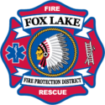FAQ
General Questions
Founded in 1908, the Fox Lake Fire Protection District proudly employs highly trained men and women in all aspects of firefighting and emergency medical services. All members must attend trainings throughout the year to keep their certifications up to date. The men and women of the Fox Lake Fire Protection District are very dedicated to providing the highest quality fire and EMS service around. We are very active within the community and our members participate in various events year round. We attend block parties, teach fire safety to people of all ages, hold CPR and First Aid classes, install car seats, and hold an annual open house. The area we protect is very unique in the fact that it goes all the way to the Wisconsin border on Wilmot Road, to the entrance of the Fish Lake Beach Campgrounds on Route 12, to the area of Baxter Laboratories by Wilson Road and Route 120. The Lake/McHenry Counties border to the west and the Avon and Lake Villa Townships border on the East. Our fire protection district encompasses 30 square miles and has a population of approximately 33,000 people which more than doubles in the summer months. We operate out of three stations that protect a primarily residential area. Our call volume has been increasing on a yearly basis due to the increased number of residential homes being built and the newly opened businesses within our district. The men and women of the Fox Lake Fire Protection District pride themselves in not only providing the best Fire and EMS services, but also being positive role models within the community.
Yard waste generated on premises only, at least 30 feet from any structure during the months of April & May, Sept., Oct and Nov. Check with your local village ordinances if there are any questions.
Smoke Alarm Questions
Every year in the United States about 3,000 people lose their lives in residential fires. In a fire, smoke and deadly gases tend to spread farther and faster than heat. That’s one reason why most fire victims die from inhalation of smoke and toxic gases, not as a result of burns. A majority of fatal fires happen when families are asleep because occupants are unaware of the fire until there is not adequate time to escape. A smoke alarm stands guard around the clock and when it first senses smoke, it sounds a shrill alarm. This often allows a family the precious but limited time it takes to escape.
About two-thirds of home fire deaths occur in homes with no smoke alarms or no working smoke alarms. Properly installed and maintained smoke alarms are considered to be one of the best and least expensive means of providing an early warning of a potentially deadly fire and could reduce the risk of dying from a fire in your home by almost half.
There are 3 types of smoke alarms.
1. Ionization
2. Photoelectric
3. Ionization/Photoelectric ie. Duel Sensor
It is suggested the best one to buy is the Duel Sensor. This one covers both types of fires. Ionization: Free Burning, Photoelectric: Smoldering.
Install a working smoke alarm on every level of the home, outside sleeping areas and inside bedrooms.
DO NOT place a smoke alarm too close to a kitchen appliance or fireplace, as this may result in nuisance alarms. Also avoid locating smoke alarms near bathrooms, heating appliances, windows or ceiling fans.
Replace smoke alarm batteries at least once a year, such as resetting your clocks in the spring or fall. (CHANGE YOUR CLOCKS CHANGE YOUR BATTERIES)
Smoke alarms should be replaced every 10 years.
Carbon Monoxide Detector Questions
Often called the invisible killer, carbon monoxide is an odorless, colorless gas created when fuels (such as gasoline, wood, coal, natural gas propane, oil and methane) burn incompletely. In the home heating and cooking equipment that burn fuel can be sources of carbon monoxide.
There are several kinds of CO detectors.
1. Battery operated.
2. Plug in
3. Combination smoke/co detectors.
Outside of all sleeping areas. (Good rule of thumb is within 15 ft. of the sleeping areas.)
